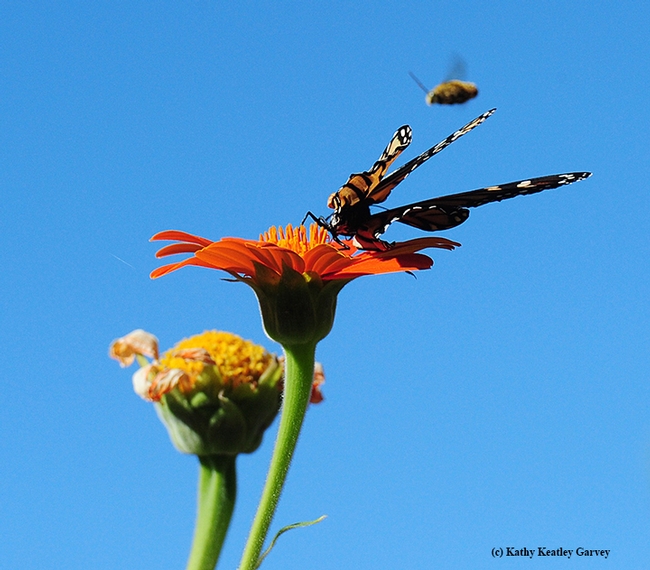So here's this newly eclosed male monarch trying to sip a little nectar from a Mexican sunflower (Tithonia).
A female longhorned bee, probably Melissodes agilis, seeks to claim it. There's no such thing as sharing, especially when nectar is at stake and it's first-come, first-served. However, the monarch is well positioned. There's no room for both a butterfly and a bee. Not at the same time.
Then a male longhorned bee (probably Melissodes agilis) targets the monarch. Shoo, monarch! Outta here! I'm saving that flower for my girl!
If you look closely at the male bee/male monarch photo, you can see the monarch's wings don't seem quite right. They're not. Greg Kareofelas, associate at the Bohart Museum of Entomology, UC Davis, points out that "the wings are deformed; they did not fully expand and dry straight."
As for the longhorned bee, Melissodes agilis is one of more than 1600 species of undomesticated bees that populate California.
To learn more about bees in California, get a copy of the landmark California Bees and Blooms: A Guide for Gardeners and Naturalists (Heyday), the work of bee experts Gordon W. Frankie of UC Berkeley and Robbin W. Thorp of UC Davis, photographer/entomologist Rollin E. Coville, and UC Berkeley botany expert Barbara Ertter.
All have UC Berkeley connections. Thorp, distinguished emeritus professor of entomology at UC Davis, received his doctorate in entomology from UC Berkeley. Coville, who took the amazing, incredibly detailed photos for the book, also received his doctorate in entomology from UC Berkeley.
The book also includes information on 53 bee friendly plants--like Tithonia!--and how to grow them.
Tithonia, a member of the sunflower family Asteraceae, is a favorite of insects. Pull up a chair at a Tithonia patch near you and observe the diversity of foraging insects. Among them: honey bees, bumble bees, sweat bees, longhorned bees, and assorted butterflies, including monarchs, Western tiger swallowtails, Gulf Fritillaries, skippers, California buckeyes, mournful duskywings, painted ladies, and cabbage whites. And oh, some predators, too, including praying mantids and wasps (insects) and crab spiders and orb weavers (spiders).
There's never a dull moment in the Tithonia patch.
Attached Images:

A pollen-packing female longhorned bee, probably Melissodes agilis (as identified by Robbin Thorp, emeritus professor of entomology at UC Davis) wants the same flower that the male monarch has claimed. This is a Mexican sunflower, genus Tithonia. (Photo by Kathy Keatley Garvey)

Just a blur, a male longhorned bee, probably Meliossodes agilis, targets a monarch. The monarch's wings are deformed; they did not fully expand. (Photo by Kathy Keatley Garvey)